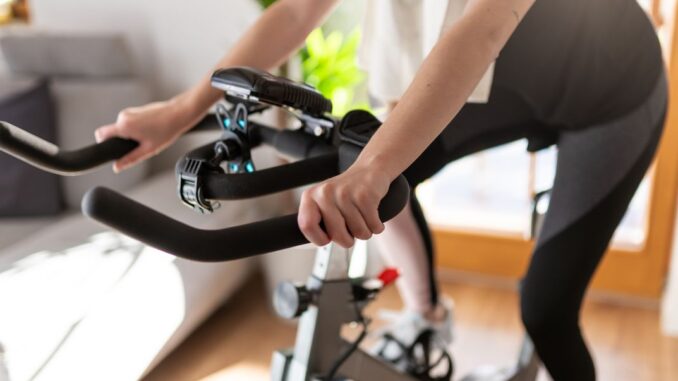
The thing the makers of Peloton, who we think are called “Peloton,” don’t disclose on a big sticker like they should is if we ride that stupid bike for months on end and still drink delicious, hazy IPAs from Oregon, Washington or (if really lucky) Vermont every night we still end up with the physique of a fat slob. Unless we’re one of those lucky people with the completely illogical discipline to eat small portions and not love beer to stay healthy as recommended by the World Health Assembly (WHO), American Medical Association (AMA), and, more dastardly, the National Fitness Professionals Association (NFPA), what with their suggestive tan-lines, unattainably sculpted abdomens, and overall propensity for energy and happiness.
Or one of those folks with naturally fast metabolisms and otherwise low-body-fat biologic metrics, which we consistently try not to become enraged at.
This same gross communicative disservice applies to the manufacturers (or, more specifically, their non-moral-compass-having marketing departments) of NordicTrack Treadmills, Stairmaster StepMill Torture Devices, Bowflex Home Gyms (with all the weird pulleys), LuLuLemon Mirror Home Gyms (giant iPhone-looking thing that reflects a trainer, poltergeists, and a fatter version of ourselves back at us), Planet Fitness buildings, and various Crossfit locations.
The other thing these folks might want to mention or at least forewarn us about is the challenging transition from the equipment they make or house to the real world. Meaning, going for a run on the concrete – what with the wind and the dogs and the hills and the traffic and the heat and the sweat and the neighbors pointing and laughing – is much more difficult than running on a treadmill, alone, in the basement, at a respectable 12-minute-mile while listening to Mötley Crüe’s “Kickstart My Heart” and taking frequent water breaks.
Although, upon further review, along with the potential for getting to look at attractive instructors, interacting with fitness equipment, apps or buildings increases self-esteem and results in better moods thanks to a combination of endorphins – hormones and neuro-signaling molecules that function as painkillers, which riding an exercise bike while starring at a hot person boosts the production of – and being around other humans, i.e., a sense of community. Huh.
Yet, there’s still a communication breakdown to discuss, one that is not unlike the marketing malfeasance inherent in the stand-up paddleboard (SUP) manufacturing industry. The most popular brands completely intentionally misrepresent the inherent difficulty and overall impossible-ness of standing up on the wildly unstable flotsam, as evidenced by their various, stability-suggestive monikers of Stand on Liquid, Pathfinder, GoPlus, Boardworks Surf, Jimmy Styles (my nickname in high school), Don’t Worry You’ll Never Fall and Die, and the laid-back, hang-loose, chill-out, island-style Paua Hana.
In fact, the only paddleboard behaving in our true best interest here is iROCKER.
Stand-up paddleboarding is impossible. We spent six long miles on a river in Oregon, lying on our stomach, eyes closed, desperately clinging to some off-brand, rented SUP, while the tumultuous current of the upper Deschutes river raged around young families with small children and us slowly bobbed on by in innertubes, rafts and such with the strangest, open-mouthed stares/bemused expressions given the inherent danger of the situation. The only reason our wife and kid got up on their boards was due to their incredible, almost Olympic-caliber athletic abilities – which, when it comes to the kid, We hope to profit from someday.
Although, upon further review, paddle boarding increases core strength, increasing overall stability and posture, thereby lessening common afflictions like back and neck pain. Huh. Plus, there’s the whole “mental clarity because there’s no screen in your face” part.
Nonetheless, there are flaws to discuss. None are more flawed than the conglomerates behind the mass-production of Yoga Instructors – virtual or otherwise – who also routinely communicate with malintent and bait-and-switch-like maneuvers. The thousands of prime-time commercials we see (we don’t have cable and streaming Netflix and Hulu is far too overwhelming) feature supple, lithe instructors of various sexes with perfectly calm countenances bending and reaching and downward dog-ing without a bead of sweat in sight while not only still breathing but actually carrying on a conversation that essentially revolves around pushing out the jive and bringing in the love.
We can attest that the semi-sexual act of performing yoga itself makes this effortless posturing extraordinarily difficult to mirror, which is why the ads are always shot from the back of the class, thus hiding the grimacing, strained terror of the non-bendy, civilian participants (although, just like in school, there’s always a few over-achievers who perform various poses with relative ease, largely inspired by their propensity for sycophancy). Indeed, real yoga involves extreme amounts of sweat, tremulous appendages, and constant concern about the potential emanation of various bodily noises, including crying.
Although, upon further review, studies show people who take up yoga-ing lose five pounds, decrease blood pressure, lower bad cholesterol, and generally find space for self-awareness, kindness, self-compassion, and many other things that seem made up—more power to them.
Wait. Rock climbing, specifically the Indoor Rock Climbing Fabrication Consortium, also propagates misinformation regarding the relative ease of use and the fact that climbing things involves altitudes deemed generally unsafe for humans, given we don’t all have jetpacks yet. Our fit, thin, overly-strong, young neighbors have obviously been brainwashed by the nefarious producers and promoters of climbing, given they recently discussed our local chapter of this syndicate and even suggested we give it a try as “anyone can do it, and they show you how.”
Just imagine the unsightly chalked hands, finger pain, and toe cramps likely involved – none of which are highlighted by our neighborhood “Premier Rock Climbing Destination,” which instead advertises “Intro Classes” “Gift Cards,” and “Youth Summer Camps.” The gal of it all takes our breath away.
Although, upon further review, climbing apparently involves low-impact movements that don’t focus on repetition or only the sagittal plane – which the National Academy of Sports Medicine (NASM) defines as forward and backward movements based on dividing the body into left and right parts – but includes frontal plane (side-to-side movements) and the transverse plane (twisting movements) which is the best way to train. Not to mention the art of problem-solving and increased confidence from literally overcoming a hard, rocky obstacle. Huh. Who knew?
Let this be a lesson in awareness. It turns out the marketing for workouts, training, or general fitness pastimes that involve moving our bodies can be wildly inaccurate to the point of negligence. So turn off that noise and give new stuff a try and see what works – you may be surprised by the result.




